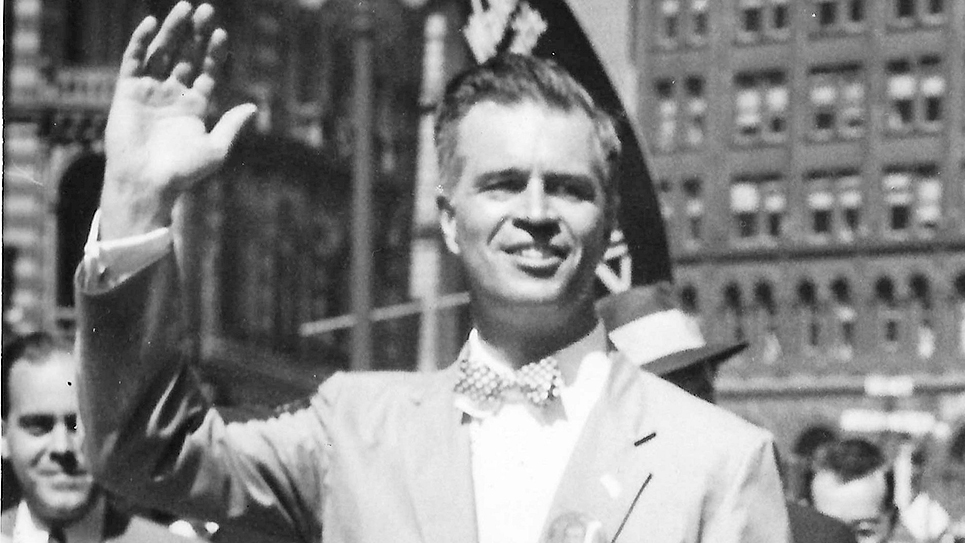By Ray Hill
Cate was a familiar name to voters in Knox County, especially when they were picking a sheriff. William T. Cate had been sheriff and J. Carroll Cate was sheriff from 1936 – 1940. In 1946, six-foot-five, 350-pound Hazen Kreis was leaving the sheriff’s office, having served three two-year consecutive terms. Kreis was highly popular and his chief deputy, Bruce Newman, was a declared candidate for the Republican nomination to succeed him. So was Austin Cate, son of former Sheriff W. T. (William Thomas) Cate and cousin of Carroll Cate, who was both a former sheriff and Knox County Property Tax Assessor. Carroll Cate was preparing to assume yet another office, that of clerk of the federal court headquartered in Knoxville. The forty-four-year-old Austin Cate had been a guard in Alcoa for the past few years and had experience as chief jailer and chief deputy sheriff under the administration of his cousin, Carroll. The forty-five-year-old Newman had been chief deputy under Sheriff Hazen Kreis for the past three years and had served a few months in the Army. Neither Austin Cate nor Bruce Newman had ever been elected to public office prior to the 1946 campaign. Yet another Cate, Horace, was resigning as chief deputy County Court Clerk to become a candidate for the Clerk of the Criminal & Domestic Relations Courts.
Austin Cate and Bruce Newman did not have the GOP primary to themselves as O. B. Baskette, a fifty-year-old Southern Railway fireman declared he, too, was a candidate for Knox County sheriff. A veteran of the First World War, Baskette had apparently been a deputy sheriff during the administration of Walter Anderson in 1925. As Baskette announced himself a candidate, Austin Cate was outlining his platform to become Knox County’s sheriff. Cate contended the sheriff was less a street policeman than an executive running a department.
“This county has grown so in population that the day of the two-gun sheriff is over,” Cate said. “The sheriff should give more time to his office, performing the various duties there, and that’s what I’ll do if elected.” Cate pointed to his own experience, having worked “in a protective capacity in one of the largest war plants for the duration” of much of the Second World War.
In the past, many occupants of the sheriff’s office continued running their ordinary day-to-day business pursuits while occupying a public office that paid a handsome salary. Austin Cate campaigned on the theme he would be a “full-time” sheriff.
Around 13,000 voters trudged to the polls on March 14, 1946, the biggest number ever attracted to a local Republican primary at the time. That election saw Miss Mildred Doyle edge out William W. Morris for the GOP nomination for superintendent of Knox County schools. Both Austin Cate and Horace Cate won the Republican nomination for sheriff and criminal court clerk respectively. Austin Cate had nudged out Bruce Newman 6,499 to 5,687. O. B. Baskette polled a meager 732 votes countywide.
Cate published a paid advertisement following the heated primary directly asking for the vote and support of those who had voted for his primary opponents. “To those who saw fit to support my opponents I want to assure them that I have only the best of feelings for them because no one could object to their supporting my opponents who are both life-long Republicans and splendid gentlemen.” Austin Cate paid tribute to his former primary opponents for having waged “hard” but clean campaigns.
The decade of the 1930s had not been kind to the Republican party nationally. 1932 saw the rise of Franklin D. Roosevelt and FDR dominated national politics until his untimely death in 1945. Democrats had also dominated both houses of Congress and while locally Republicans more than held their own in Knox County, the Grand Old Party would have one of its best years in 1946. Indeed, a Tennessean presided over the Republican National Committee. Carroll Reece, a longtime congressman from Tennessee’s First District, had been elected RNC chairman and the Tennessean quarterbacked a campaign that shrewdly took advantage of the voters’ dissatisfaction with the deprivations imposed due to the Second World War. “Had Enough” would be the simple, yet quite effective slogan used by the Republican Party to win back control of both the House of Representatives and the United States Senate for the first time since the advent of Franklin Delano Roosevelt.
The Democrats made a decent showing in Knox County, but not enough to win. The Republicans swept the courthouse and Austin Cate won his first term as sheriff, beating Paul Lilly 15,538 to 12,147. Cate won just over 56% of the ballots cast. Days later, Austin Cate published ads in both of Knoxville’s daily newspapers thanking his supporters and assuring those who had not voted for him that the sheriff-elect had no hard feelings because his opponent “is a good man.” One doesn’t hear that much today. The photograph of Austin Cate would become the standard for the sheriff. Neatly dressed in a suit and tie, Cate was also wearing a hat, standard business attire for the time. Cate’s son Richard still has vivid memories of how his Dad was dressed. “He always wore a suit and tie and a hat,” Richard Cate told me. That is almost always how Knox Countians saw Sheriff Austin Cate. To friends, the sheriff was known as “Dick” Cate.
Cate took the oath of office as Knox County Sheriff for the first time at midnight on August 31, 1946, as September 1 fell on a Sunday, which was administered by Judge John Kelly. Of course, the sheriff’s department operated on a round-the-clock basis, unlike most other county offices. Cate also made his first hire when Mrs. Lucy Dunn resigned from the criminal court clerk’s office to accept a position as the new sheriff’s personal secretary. Mrs. Dunn had been the personal secretary to former Sheriff J. Carroll Cate for two years before moving to the criminal court clerk’s office. Neither Chief Deputy Sheriff Bruce Newman, who had contested the GOP nomination with Cate, nor Mrs. Amos Caldwell, the personal secretary to Sheriff Hazen Kreis, were going to be working under the new administration. Newman accepted an offer from Knox County Clerk Jack Dance to work in that office. Several months later, Sheriff Austin Cate likely stunned many when he appointed his former primary opponent as chief deputy on the night of August 13, 1947. Cate explained he had never held any kind of a grudge against Newman, they had grown up together and had run against one another in the 1946 GOP primary and noted: “they are still personal and political friends.” Cate told a newspaperman he was “certain” Newman was the right man for the job based upon his previous 14 years of experience in the sheriff’s department. Former Acting Chief Deputy Sheriff C. A. Hobbs explained he “lives too far away from Knoxville” to devote the time needed for the job. Hobbs lived sixteen miles from Knoxville on Kingston Pike. Hobbs thought the chief deputy should live near downtown and the county jail.
As the primary and general elections loomed in 1948, there was little doubt about the activity in the Knox County Sheriff’s Department. Under Sheriff Austin Cate, the department received continuous attention from the news media of the day, newspapers and radio. Cate and his men seemed to be constantly after some lawbreaker, pouring out moonshine, closing illegal gambling dens and destroying the confiscated equipment and the like, which is politically mighty good for an elected chief law enforcement officer. In spite of his record and activity, Cate drew a formidable opponent in the primary in the person of Ed Burchfield. Burchfield had been elected as one of Knox County’s three “Commissioners,” one of which served over Finance, another over Welfare, and the last over Highways. Ed Burchfield had served two terms as Commissioner of Finance before running against Austin Cate for sheriff. Burchfield’s father, Joe, had been a prominent automobile dealer and well known throughout Knox County. Burchfield had not run for reelection in 1946. Ed Burchfield was on the political comeback trail and the South Knoxvillian did not run a campaign on the issues. The advertising for Burchfield’s bid to be sheriff inferred the administration of Austin Cate was dishonest. Burchfield had a wide ranging platform of reforms for the sheriff’s office, which included hiring Black deputies to patrol in the predominately Black sections of Knoxville.
Sheriff Cate gave his employees a “pep talk” and urged each of them to “work their precincts” in the coming election. Cate spoke to “some 65 of his uniformed and court deputies” in the criminal courtroom. Mrs. Lucy Dunn, the sheriff’s personal secretary, was also the president of the Knox County Republican Women’s Club and not surprisingly, she endorsed her boss for reelection.
“It would increase the tax rate 25 cents on the dollar to get everything Sheriff Cate’s opponent (Ed Burchfield) wants,” Mrs. Dunn insisted. “It has been impossible to live up to all pre-election promises because Sheriff Cate could not get money for better facilities from County Court.”
Burchfield retorted enlarging the number of deputies as well as a “strict law enforcement policy” would cover the expenses incurred in running the jail. Burchfield noted the population of Knox County had quite nearly doubled and he reasoned that meant the county therefore needed twice the protection. Ed Burchfield somewhat dubiously explained it was unnecessary to place an increased burden upon the taxpayer, but rather by pursuing a policy of “alter law enforcement” it would pay for itself. Knox County received $1 for every prisoner held in the jail, as well as $1 for every prisoner released, and $1.10 each day for boarding prisoners.
Ed Burchfield’s newspaper advertisements were reminiscent of those run by incumbent Austin Cate. Wearing a hat and dressed in a suit and tie, Burchfield advertised himself as “Honest, Capable, Efficient, and Fearless.” Burchfield’s advertising proclaimed the people of Knox County “NEED a NEW Sheriff – – -.” Burchfield’s newspaper ads said the “present incumbent” had been involved in law enforcement activities “for a number of years – – – almost continually since he was employed as a chauffeur in the Sheriff’s office while his father was Sheriff of Knox County.” “He has never been outstanding,” the Burchfield advertisement declared of Austin Cate. “His self-confessed mistakes while serving his present term as Sheriff have been the outcome of years of mediocre experience at the taxpayers’ expense.” The inference of the Burchfield advertising was, naturally, the former Finance Commissioner was the superior of Austin Cate in every way.
The Republicans of Knox County did not agree. Austin Cate romped to victory with an overwhelming majority of 7,966 votes as compared to only 2,542 for Ed Burchfield. Cate won a whopping 76% of the ballots cast by GOP voters in Knox County. Austin Cate’s personal popularity was demonstrated by the fact he still polled more votes than many of his fellow officeholders who were unopposed on the ballot. Trustee C. A. “Lum” Reeder received 7,543 complimentary votes; Property Tax Assessor Ed Hill garnered 7,552 complimentary votes; County Judge Joe C. Strong got 7,197 complimentary votes.
Sheriff Austin Cate faced Democrat C. W. “Buddy” Jones in the 1948 general election. The two would contend with one another in no less than three elections. The Knoxville News-Sentinel referred to Jones as a “sportsman – businessman”, an interesting appellation for a candidate for Knox County Sheriff. Cate had no difficulty dispatching Jones in the general election, winning 17,5611 to 10,793 for Jones. The GOP ticket won handsome victories save for County Judge Joe Strong who was upset by C. Howard Bozeman. Sheriff Cate led the Republican ticket.
Austin Cate had amply demonstrated his popularity not only with the rank and file of the Republican Party but also with the people of Knox County. Yet Sheriff Cate would learn the bitter lesson of politics: anyone can be beaten.






